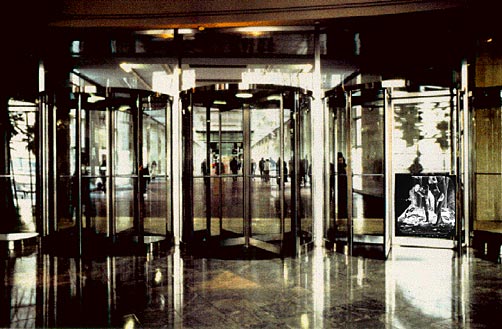 |
Tambour 1996
Proposition d’une installation sur des portes à tambour
au World Financial Center, New York
Tambour
proposition for 6 revolving doors, World Financial Center, New York 1996.
|
Ce projet consiste à proposer une interprétation des relations entre un lieu de passage et le temps de la perception.
Lors de l’un de mes voyages à new york, j’avais disposé et déployé en cercle sur une table ronde dans la chambre de mon hôtel, une maquette réalisée à partir d’images stéréoscopiques érotiques que j’avais passées dans mon fax jusqu’à disparition de l’image.
A New York, les portes à tambour sont extrêmement présentes : passage de l’intérieur vers l’extérieur, du privé vers le public, seuil de lenteur, espace de protection, lieu de surveillance, caisson d’isolement, de mouvement.
Une relation évidente entre les images déployées en tourniquet et les portes à tambour s’est établie pour moi immédiatement.
Ma proposition est une installation sur des portes tournantes au World Financial Center à New York
Ce lieu est un endroit de passage entre le monde des affaires et un espace de détente The Winter Garden : va-et-vient entre le monde de la finance et le jardin d’hiver, métaphore du paradis perdu. Sur les vitres des 6 portes à tambour situées au North Bridge du World Financial Center sont collées des sérigraphies détournant l’espace public en espace intime, privé. Les images créées en négatif à partir d’une photographie érotique stéréoscopique sur plaque de verre représentent une métaphore du paradis perdu. Je ne connais ni l’auteur, ni la date de prise de vue. Sur les battants de chaque porte, quatre étapes de cette série d’images sont imprimées en noir et blanc sur fond de miroir.
L’idée de la stéréoscopie est traduite par l’image de gauche imprimée sur le battant situé derrière le spectateur, l’image de droite se trouvant devant lui.
En entrant dans la porte à tambour, le spectateur devient conscient de lui-même en percevant son corps dans un espace social et qui le met aussi en relation avec lui. L’image et le miroir détournent l’attention du spectateur pour la reporter sur le détail de son corps reflété dans la scène le temps du passage. Il avance ainsi entre deux images.
A un certain moment, il se trouve enfermé dans un espace triangulaire, avant d’effectuer le passage et ressortir de l’autre côté du tambour. F. Z
Proposition
This project proposes an interpretation of the relationships between a place of through passage and the moment of perception.
During one of my trips to New York, I had placed the dummy of a book standing upright and opened out in a circle on a table - the book was composed of photocopies on tracing paper of stereoscopic erotic pictures that I had put through my fax until the picture disappeared completely.
Also on that trip I noticed that revolving doors are very common.
They are places of transition from the interior to the exterior, from a private space to a public place, a threshold of slowness, an area of protection, a place of surveillance, and a chamber of isolation and movement.
I immediately established a relationship between the pictures in the book arranged on a revolving display stand and the revolving doors.
My proposal is an installation situated in the World Financial Center.
The site is a point of transition between the world of the business and a leisure area, the Winter Garden. There is incessant coming and going between the world of the finance and the Winter Garden, a metaphor of paradise lost.
Of he glass panes of the 6 revolving doors at the North Bridge of the WFC will be placed silk screen prints on mirror paper, turning the public space into a private space and vice versa.
The pictures will be produced from an original anonymus stereoscopic photograph on a glass plate. Four stages of this series of pictures will be printed on the leaves of the door, in black and white on a mirror background.
The idea of stereoscopy is conveyed by the left-hand picture printed on the leaf that is behind the observer, while the right-hand picture is in front of him/her.
Upon entering the revolving door, the observer becomes conscious of him/herself, perceiving his/her body in a social space that also relates the observer to him/herself. The picture and the mirror attract the observer’s attention to the details of his/her body reflected in the scene during the time it takes to pass through the revolving door.
So the observer moves forward between two pictures and, at a certain moment, is enclosed within a triangular space, before passing through and going out the other side. |
|
|
|